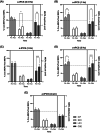Investigating the Effects of Anodal Transcranial Pulsed Current Stimulation at Low Frequencies (0.5 to 5 Hz) on Corticospinal and Corticocortical Excitability
- PMID: 40524350
- PMCID: PMC12171088
- DOI: 10.1111/psyp.70092
Investigating the Effects of Anodal Transcranial Pulsed Current Stimulation at Low Frequencies (0.5 to 5 Hz) on Corticospinal and Corticocortical Excitability
Abstract
The mechanism underlying transcranial pulsed current stimulation (tPCS) as a non-invasive neuromodulation technique has garnered considerable attention in recent years. However, the effects of anodal tPCS (a-tPCS) at low frequencies remain unexplored. This study aimed to investigate the a-tPCS effects at 0.5, 1, 3, and 5 Hz on cortical outcomes and its adverse side effects. This double-blinded, randomized, counterbalanced crossover trial included 18 healthy young participants who completed five experimental sessions with 2 mA of a-tPCS for 20 min in a randomized order of frequencies (0.5, 1, 3, and 5 Hz). Single-pulse and paired-pulse transcranial magnetic stimulation (TMS) on the left primary motor cortex (M1) was delivered before and immediately after the stimulation at rest. Sessions were spaced at least 48 h apart to minimize carry-over effects. The results indicated that a single session of a-tPCS at frequencies of 1, 3, and 5 Hz significantly (p < 0.05) enhanced corticospinal excitability (CSE), while 0.5 Hz decreased CSE compared to sham stimulation. The CSE changes at 1 and 5 Hz were associated with increased intracortical facilitation (ICF), with reduced adverse effects observed at higher frequencies. In contrast, the cortical effects of 0.5 Hz were linked to increased short intracortical inhibition (SICI) with minimal side effects. However, all frequencies except 0.5 Hz were associated with phosphenes or flashing lights during stimulation. Given the similar effects of a-tPCS with other pulsatile current stimulation, it is plausible that tPCS could serve as a complementary or superior alternative to TMS, particularly for at-risk and diverse patient populations. However, this claim needs further comparative studies before suggesting clinical superiority for epilepsy and neuro-rehabilitation. Furthermore, like other neuromodulation techniques, tPCS shows potential as an affordable, home-based treatment option. Further research is needed to establish the efficacy of tPCS relative to TMS methodologies through rigorous experimental testing.
Keywords: corticocortical excitability; corticospinal excitability; tPCS, low frequencies; transcranial magnetic stimulation; transcranial pulsed current stimulation.
© 2025 The Author(s). Psychophysiology published by Wiley Periodicals LLC on behalf of Society for Psychophysiological Research.
Conflict of interest statement
The authors declare no conflicts of interest.
Figures




Similar articles
-
Effects of a Single Session 400 Hz Transcranial Pulsed Current Stimulation on Corticospinal and Corticocortical Excitability and Hand Dexterity: A Double-Blind RCT.Psychophysiology. 2025 Jul;62(7):e70112. doi: 10.1111/psyp.70112. Psychophysiology. 2025. PMID: 40696723 Free PMC article. Clinical Trial.
-
Influence of gamma transcranial alternating current stimulation frequency and intensity on motor cortex excitability in young and older adults.J Neurophysiol. 2025 Aug 1;134(2):619-627. doi: 10.1152/jn.00147.2025. Epub 2025 Jul 21. J Neurophysiol. 2025. PMID: 40691054
-
Effect of transcranial direct current stimulation over the primary motor cortex on short-term balance acquisition in healthy individuals.J Neuroeng Rehabil. 2025 Jul 4;22(1):146. doi: 10.1186/s12984-025-01663-3. J Neuroeng Rehabil. 2025. PMID: 40616154 Free PMC article. Clinical Trial.
-
Does transcranial electrical stimulation enhance corticospinal excitability of the motor cortex in healthy individuals? A systematic review and meta-analysis.Eur J Neurosci. 2017 Aug;46(4):1968-1990. doi: 10.1111/ejn.13640. Epub 2017 Aug 2. Eur J Neurosci. 2017. PMID: 28699187
-
The effects of transcranial direct current stimulation on short-interval intracortical inhibition and intracortical facilitation: a systematic review and meta-analysis.Rev Neurosci. 2018 Jan 26;29(1):99-114. doi: 10.1515/revneuro-2017-0023. Rev Neurosci. 2018. PMID: 28820738
References
-
- Afifi, S. Y. 2024. “A New Era of Current and Future Treatment Applications of Transcranial Magnetic Stimulation.” Egyptian Journal of Neurology, Psychiatry and Neurosurgery 60: 54.
-
- Awiszus, F. 2003. “Chapter 2 TMS and Threshold Hunting.” In TMS and Threshold Hunting. Elsevier. - PubMed
-
- Behrangrad, S. , Zoghi M., Kidgell D., Mansouri F., and Jaberzadeh S.. 2022. “The Effects of Concurrent Bilateral Anodal tDCS of Primary Motor Cortex and Cerebellum on Corticospinal Excitability: A Randomized, Double‐Blind Sham‐Controlled Study.” Brain Structure and Function 227: 2395–2408. - PMC - PubMed
-
- Biabani, M. , Aminitehrani M., Zoghi M., Farrell M., Egan G., and Jaberzadeh S.. 2017. “The Effects of Transcranial Direct Current Stimulation on Short‐Interval Intracortical Inhibition and Intracortical Facilitation: A Systematic Review and Meta‐Analysis.” Reviews in the Neurosciences 29: 99–114. - PubMed
Publication types
MeSH terms
LinkOut - more resources
Full Text Sources

